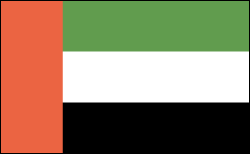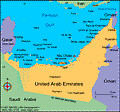United Arab Emirates | Facts & Information

- United Arab Emirates Profile
Facts & Figures
-
President: Sheikh Khalifa bin Zayed al-Nahyan (2004)
Prime Minister: Sheikh Muhammad ibn Rashid al-Maktoum (2006)
Total area: 32,278 sq mi (83,600 sq km)
Population (2014 est.): 5,628,805 (growth rate: 2.71%); birth rate: 15.54/1000; infant mortality rate: 10.92/1000; life expectancy: 77.09; density per sq mi: 256
Capital (2012 est.): Abu Dhabi, 942,000
Largest city: Dubai, 1.978 million
Monetary unit: U.A.E. dirham
National name: Al-Imarat al-'Arabiyah al-Muttahidah
Languages: Arabic (official), Persian, English, Hindi, Urdu
Ethnicity/race: Emiri 19%, other Arab and Iranian 23%, South Asian 50%, other expatriates (includes Westerners and East Asians) 8% (1982)
Religions: Muslim (Islam; official) 76%, Christian 9%, other (primarily Hindu and Buddhist, less than 5% of the population consists of Parsi, Baha'i, Druze, Sikh, Ahmadi, Ismaili, Dawoodi Bohra Muslim, and Jewish) 15%. Note: represents the total population; about 85% of the population consists of noncitizens (2005 est.)
Literacy rate: 90% (2005 est.)
Economic summary: GDP/PPP (2013 est.): $269.8 billion; per capita $29,900. Real growth rate: 4%. Inflation: 1.3%. Unemployment: 2.4% (2001). Arable land: 0.61%. Agriculture: dates, vegetables, watermelons; poultry, eggs, dairy products; fish. Labor force: 4.588 million; note: 85% of the population in the 15–64 age group is nonnational (2013 est.); services 78%, industry 15%, agriculture 7% (2000 est.). Industries: petroleum and petrochemicals; fishing, aluminum, cement, fertilizers, commercial ship repair, construction materials, some boat building, handicrafts, textiles. Natural resources: petroleum, natural gas. Exports: $368.9 billion (2013 est.): crude oil 45%, natural gas, reexports, dried fish, dates. Imports: $249.6 billion (2013 est.): machinery and transport equipment, chemicals, food. Major trading partners: Japan, South Korea, India, Thailand, China, Germany, Iran, U.S., Singapore (2012).
Communications: Telephones: main lines in use: 1.967 million (2012); mobile cellular: 13.775 million (2012). Radio broadcast stations: except for the many organizations now operating in Dubai's Media Free Zone, most TV and radio stations remain government-owned; widespread use of satellite dishes provides access to pan-Arab and other international broadcasts (2007). Radios: 820,000 (1997). Television broadcast stations: 15 (1997). Televisions: 310,000 (1997). Internet Service Providers (ISPs): 337,804 (2012). Internet users: 3.449 million (2009).
Transportation: Railways: 0 km. Highways: total: 4,080 km; paved: 4,080 km; unpaved: 0 km (2008 est.). Ports and harbors: Al Fujayrah, Mina' Jabal 'Ali (Dubai), Khor Fakkan (Khawr Fakkan), Mubarraz Island, Mina' Rashid (Dubai), Mina' Saqr (Ra's al Khaymah). Airports: 43 (2013).
International disputes: Boundary agreement was signed and ratified with Oman in 2003 for entire border, including Oman's Musandam Peninsula and Al Madhah enclaves, but contents of the agreement and detailed maps showing the alignment have not been published; Iran and UAE dispute Tunb Islands and Abu Musa Island, which Iran occupies.









